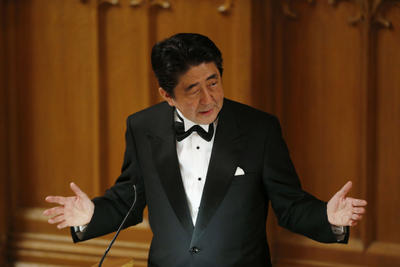Although the monetary easing and fiscal stimulus packages boosted business confidence and led to record gains in the Nikkei, there are still a number of risks to Japan’s economic outlook. Japan’s export market shrinks as the global market — and the US economy — continue to slow. Also, the ageing of Japan’s population will continue and take a serious toll on the workforce, leading to lower growth potential. Moreover, wage growth has been abysmal despite inflation rising at an annual rate of 1.5 per cent.
The best way to offset these realities is for the government to implement a strong third arrow and promote Japan’s full growth potential.
In January, the Abe administration introduced an ‘action plan’ sending over 30 pieces of cabinet-endorsed legislation to the Diet. These bills are part of the third arrow and are designed to promote competition in the power sector, strengthen corporate governance, establish special economic zones to incubate new businesses and attract foreign direct investment, increase financial support for workers on childcare leave, and create a Japanese National Institute of Health.
Despite an increase in the consumption tax and some drops in the Nikkei, the Abe administration is still popular among the general public and has firm control over both houses of the Diet. All legislation from the action plan will likely be approved before the current Diet session ends on 22 June. Of the proposed bills, only about a third of them will have a significant impact. They can be broken into four broad categories: promotion of innovation, reduction in subsidies for rice cultivation, enhanced labour market flexibility, and increased competition in the power sector.
The Abe administration wants to foster innovation and increase competition, and the Industrial Competitiveness Enhancement Act that was passed last December and put into effect in January does just that.
The Abe administration is also beginning its battle with the well-established rice farmers lobby. The two relevant bills will phase out the 40-year-old rice price support system by offering compensation in return for limiting the amount of land farmers use for rice cultivation. That being said, the rice farmers lobby is attempting to replace the old subsidies with a new subsidy program.
In order to enhance labour market flexibility, the Abe administration proposed five cabinet bills that aim to increase workforce participation. These bills are intended to prohibit discriminatory treatment of women and foreigners, as well as provide more benefits for non-traditional workers such as part-time workers, temporary workers, and contract workers.
And in order to promote competition in the power sector, the Abe administration proposed a cabinet bill which would liberalise the retail electricity market by 2016. The government is trying to continue its plan to break up regional utility monopolies. It hopes that by doing so it will promote innovation, competition, and increased use of renewable energy sources.
There isn’t much that can be done to derail the passage of the cabinet bills before the Diet session ends in June. The opposition’s effort to obstruct Abe’s legislative agenda and undermine his popularity has failed. Abe’s government continues to hold firm control over both houses of the Diet, as the Democratic Party of Japan and other opponents are unorganised and ineffective at creating a central message.
Although all of these bills will pass and make a contribution to Abe’s third arrow, there is much more that needs to be done. For the crucial third arrow to be seen as a success, there needs to be a significant rise in forecasts of real future growth, followed by lower inflation expectations. In order for the Abe administration to see these results, it would be wise of them to encourage Japan’s growth potential by enabling female employment and removing product market regulations.
More than 60 per cent of women leave the workplace when they give birth to their first child, and as a result male labour force participation is a full 21 per cent higher than that of women. If female employment rates were to increase to the same level as males over the next 20 years, it would result in a jump in GDP of up to 20 per cent. As Japan’s labour shortage looms in the near future, greater involvement of women will be critical in addressing this problem. The Abe administration has introduced a few bills that address female discrimination in the workplace, but more must be done. Companies should be required to publicly report on their family-friendly workplace practices, including on the number of mothers who return to work and the number of women in senior management.
The Abe administration has set a target of increasing output growth to 2 per cent, well above the ten-year average of 0.75 per cent. In order to reach this goal, the Japanese government must propose bold structural reforms in all sectors that optimise growth potential. In particular, Tokyo must boost productivity in the service sector, which can be accomplished through reforms to strengthen competition. By simply reducing exemptions to the Anti-Monopoly Act, the Abe administration would be making significant upgrades to its competition policy. Furthermore, reducing entry barriers would promote entrepreneurship and business start-ups — both of which Japan sorely lacks.
Abe will likely see all 33 of the bills associated with his January action plan receive approval from both houses of the Diet. But no matter the importance of the bills, their impact on Japan’s economy will likely be limited. Much more needs to be done by the Japanese government in order to make the third arrow as successful as the first two.
Stephen Stapczynski is a Public Affairs and Public Relations Associate at the Sumitomo Corporation and the author of the Izakaya Politics blog on Japanese politics and US–Japan relations.

